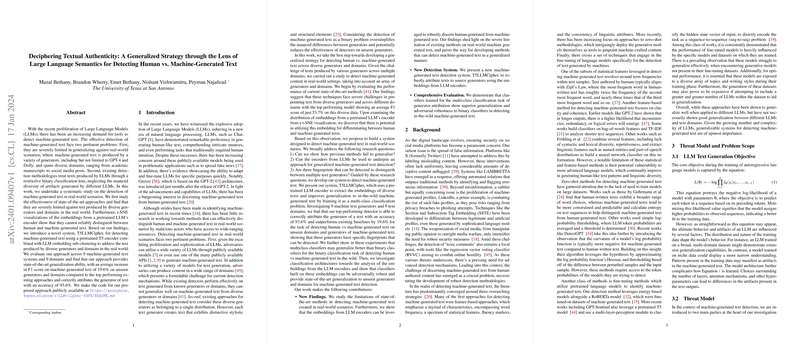Overview of the Paper
The expansion of LLMs like GPT-3 and its ilk has revolutionized language processing, producing text that's often indistinguishable from human writing. This advancement creates a pressing need for systems that can identify whether the text was written by a human or generated by a machine. Existing detection methods, however, struggle with the diversity of text generators and domains encountered in real-world contexts. This paper presents a critical analysis of these limitations and introduces T5LLMCipher, a new system designed to improve the detection of machine-generated text. It combines a pretrained T5 encoder with a novel approach that uses embeddings sub-clustering. The system demonstrated superior capabilities, outperforming state-of-the-art methods when tested across various LLMs and content domains.
State-of-the-Art Limitations & Proposed Approach
State-of-the-art methods for detecting machine-generated text often fall short in real-world applications. They are generally limited by two significant issues - firstly, their inability to generalize across the wide array of generators and domains, and secondly, their oversimplification of the problem to a binary classification task, ignoring nuanced differences between generators. To address these issues, the authors propose T5LLMCipher. This system applies the embeddings from a pretrained T5 encoder to create a detection mechanism that can accurately identify and attribute machine-generated text to its respective generators, thereby recognizing specific 'fingerprints' unique to different text-producing LLMs.
Insights from Embedding Analysis
The core of the system is informed by the analysis of embeddings—high-dimensional representations of text content generated from an existing LLM encoder. These embeddings can capture the linguistic nuances and distinct features that differentiate human from machine-generated text. Through a technique known as t-SNE visualization, a sort of text mapping, the authors found that machine-generated text does bear identifiable characteristics that can be quantitatively discerned. This discovery was key in designing a system that can not only detect but also attribute the text to particular generators effectively.
Validation and Results
Comprehensive testing was conducted to validate the new system. T5LLMCipher was tasked with identifying machine-generated text within nine different text domains against nine machine text generators. The evaluation revealed that T5LLMCipher improved detection by an average of 19.6% compared to existing approaches and achieved an impressive 93.6% accuracy in attributing the generator of text. Furthermore, the system demonstrated resilience against adversarial attacks aimed at bypassing detection mechanisms, a scenario increasingly relevant as machine-generated text becomes more prevalent and sophisticated.
In summary, the research confirms that while the current state-of-the-art detectors are limited in their practical application, the innovative use of LLM encoder embeddings presents a promising avenue for accurately detecting and classifying machine-generated text in a variety of real-world scenarios. The T5LLMCipher stands as a substantial advancement, bringing us closer to effectively discerning the authenticity of digital content in an era distinguished by machine learning's growing influence on text creation.
